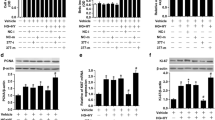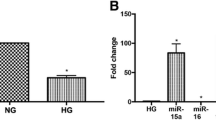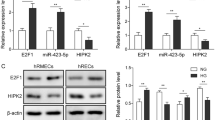Abstract
Pathological angiogenesis leads to the development of retinal vasculopathies and causes severe vision impairment. Increased understanding of the mechanisms underlying the angiogenic behavior of retinal endothelial cells helps provide new insights for developing treatment of retinal vasculopathies. Pro-angiogenic function of miR-210 has previously been identified. However, the functional implication of miR-210 in retinal endothelial cells remains unknown. Human retinal microvascular endothelial cells (HRECs) were employed to investigate the impact of miR-210 on the angiogenic capacity of retinal endothelial cells. It was observed that without affecting the viability of HRECs, miR-210 significantly suppressed the migration and capillary-like tube formation in HRECs. Moreover, pro-angiogenic insulin growth factor 2 (IGF2) was newly identified as a direct target of miR-210 in HRECs. MiR-210 decreased the expression of IGF2 at both mRNA and protein levels in HRECs. IGF2-simulated activation of p38 MAPK was attenuated by miR-210 in HRECs. Recombinant IGF2 protein rescued miR-210-induced impairment of tube formation in HRECs. Therefore, in contrast to the previously reported pro-angiogenic function of miR-210, the current work reveals novel anti-angiogenic activity of miR-210 in HRECs. Furthermore, IGF2 is identified for the first time as a direct target of miR-210 in HRECs, adding new mechanistic insights into the expression regulation of pro-angiogenic IGF2 in human retinal endothelial cells. The current work helps increase the understanding of regulatory mechanisms underlying retinal endothelial cell physiology, justifying further evaluation for the therapeutic implications of miR-210/IGF2 interaction in the treatment of related retinal vasculopathies.








Similar content being viewed by others
References
Bharadwaj AS, Appukuttan B, Wilmarth PA, Pan Y, Stempel AJ, Chipps TJ, Benedetti EE, Zamora DO, Choi D, David LL, Smith JR (2013) Role of the retinal vascular endothelial cell in ocular disease. Prog Retin Eye Res 32:102–180
Gariano RF, Gardner TW (2005) Retinal angiogenesis in development and disease. Nature 438(7070):960–966
He L, Hannon GJ (2004) MicroRNAs: small RNAs with a big role in gene regulation. Nat Rev Genet 5(7):522–531
Li Y, Kowdley KV (2012) MicroRNAs in common human diseases. Genom Proteomics Bioinform 10(5):246–253
van Rooij E, Purcell AL, Levin AA (2012) Developing microRNA therapeutics. Circ Res 110(3):496–507
Fasanaro P, D’Alessandra Y, Di Stefano V, Melchionna R, Romani S, Pompilio G, Capogrossi MC, Martelli F (2008) MicroRNA-210 modulates endothelial cell response to hypoxia and inhibits the receptor tyrosine kinase ligand Ephrin-A3. J Biol Chem 283(23):15878–15883
Chan SY, Loscalzo J (2010) MicroRNA-210: a unique and pleiotropic hypoxamir. Cell Cycle 9(6):1072–1083
Yang Y, Zhang J, Xia T, Li G, Tian T, Wang M, Wang R, Zhao L, Lan K, Zhou W (2016) MicroRNA-210 promotes cancer angiogenesis by targeting fibroblast growth factor receptor-like 1 in hepatocellular carcinoma. Oncol Rep 36(5):2553–2562
Zeng L, He X, Wang Y, Tang Y, Zheng C, Cai H, Liu J, Fu Y, Yang GY (2014) MicroRNA-210 overexpression induces angiogenesis and neurogenesis in the normal adult mouse brain. Gene Ther 21(1):37–43
Wang P, Du X, Xiong M, Cui J, Yang Q, Wang W, Chen Y, Zhang T (2016) Ginsenoside Rd attenuates breast cancer metastasis implicating derepressing microRNA-18a-regulated Smad2 expression. Sci Rep 6:33709
Yang Q, Jia C, Wang P, Xiong M, Cui J, Li L, Wang W, Wu Q, Chen Y, Zhang T (2014) MicroRNA-505 identified from patients with essential hypertension impairs endothelial cell migration and tube formation. Int J Cardiol 177(3):925–934
Bach LA (2015) Endothelial cells and the IGF system. J Mol Endocrinol 54(1):R1–R13
Lee OH, Bae SK, Bae MH, Lee YM, Moon EJ, Cha HJ, Kwon YG, Kim KW (2000) Identification of angiogenic properties of insulin-like growth factor II in in vitro angiogenesis models. Br J Cancer 82(2):385–391
Herr F, Liang OD, Herrero J, Lang U, Preissner KT, Han VK, Zygmunt M (2003) Possible angiogenic roles of insulin-like growth factor II and its receptors in uterine vascular adaptation to pregnancy. J Clin Endocrinol Metab 88(10):4811–4817
Volpert O, Jackson D, Bouck N, Linzer DI (1996) The insulin-like growth factor II/mannose 6-phosphate receptor is required for proliferin-induced angiogenesis. Endocrinology 137(9):3871–3876
Lofqvist C, Willett KL, Aspegren O, Smith AC, Aderman CM, Connor KM, Chen J, Hellstrom A, Smith LE (2009) Quantification and localization of the IGF/insulin system expression in retinal blood vessels and neurons during oxygen-induced retinopathy in mice. Investig Ophthalmol Vis Sci 50(4):1831–1837
Wilson SH, Davis MI, Caballero S, Grant MB (2001) Modulation of retinal endothelial cell behaviour by insulin-like growth factor I and somatostatin analogues: implications for diabetic retinopathy. Growth Horm IGF Res 11(Suppl A):S53–S59
Acknowledgements
This work was supported by the Program for Professor of Special Appointment (Eastern Scholar) at Shanghai Institutions of Higher Learning (GZ2015011, TZ and GZ201764, YC), and the National Natural Science Foundation of China (81673790, YC and 81400313, QY).
Author information
Authors and Affiliations
Corresponding authors
Electronic supplementary material
Below is the link to the electronic supplementary material.
Rights and permissions
About this article
Cite this article
Yang, Q., Wang, P., Du, X. et al. Direct repression of IGF2 is implicated in the anti-angiogenic function of microRNA-210 in human retinal endothelial cells. Angiogenesis 21, 313–323 (2018). https://doi.org/10.1007/s10456-018-9597-6
Received:
Accepted:
Published:
Issue Date:
DOI: https://doi.org/10.1007/s10456-018-9597-6




